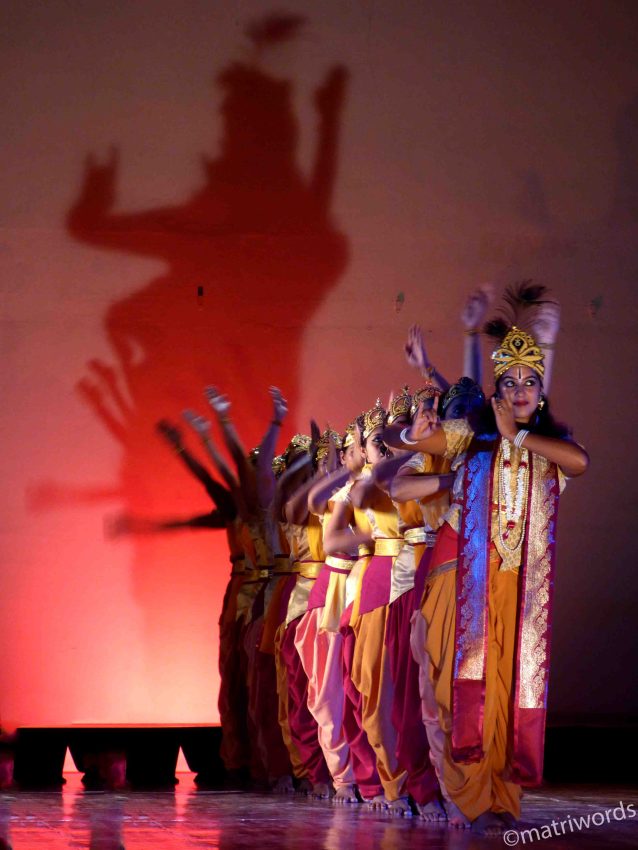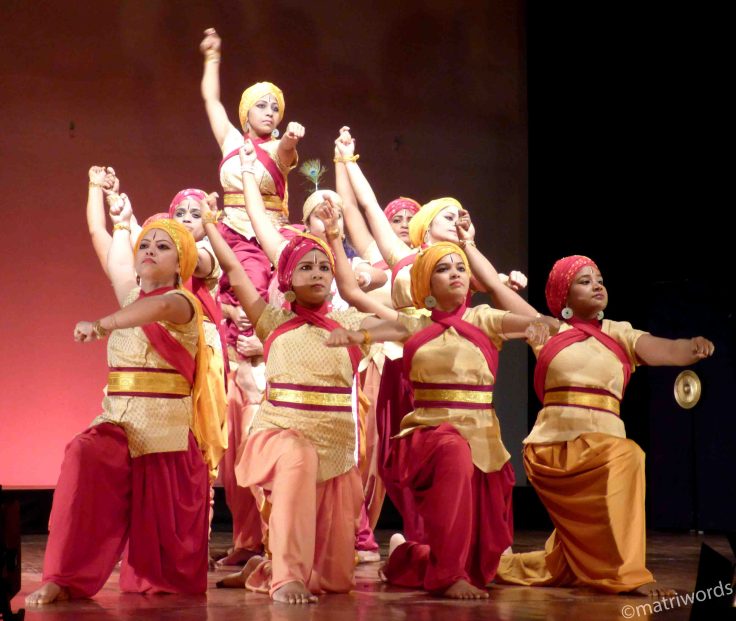CONTINUED FROM PART 2
In this part 3 (the concluding part) of our special photo-feature the focus is on Chapter 11 of the Bhagavad Gita, विश्वरूपदर्शनयोगः (viśvarūpadarśanayogaḥ), The Yoga of the Vision of the World-Spirit. Here we find one of the most powerfully poetic passages of the Gita, the vision of the Vishwaroopam, the Universal Purusha.
With our limited intellect and capability and invoking the grace of Sri Krishna and taking guidance from the relevant explanations and passages from Sri Aurobindo’s ‘Essays on the Gita’ we present a summary of the chapter.
The photographs were taken by Suhas Mehra at an exquisite dance-drama performed at Bharat Niwas, Auroville. Text is by Beloo Mehra.
This work is offered at the feet of the Mother and Sri Aurobindo, and the Eternal Flute Player and the Divine Teacher of Kurukshetra, Lord Sri Krishna.
By now, Arjuna has gained from Sri Krishna, the Divine Teacher, knowledge of the highest spiritual secret of the birth and passing away of existences and also of the imperishable greatness of the divine conscious Soul, and his delusion is dispelled. Accepting and recognising Sri Krishna as the Purushottama, he now has a desire to see his divine form and body and requests the Lord if he can be given this vision of the Divine’s imperishable Self.
Sri Krishna, the Avatar, tells Arjuna that the human eye cannot grasp what he wishes to see. But he will grant Arjuna the power of the divine eye, an inmost seeing, by which the supreme Godhead can be beheld.
“It is the vision of the One in the many, the Many in the One,—and all are the One. It is this vision that to the eye of the divine Yoga liberates, justifies, explains all that is and was and shall be.” (Sri Aurobindo, Essays on the Gita, CWSA, Vol. 19, p. 378).
Sri Krishna then shows Arjuna His Supreme Form, in which are seen hundreds and thousands of divine forms, various in kind, shape and hue, and the whole world, with all that is moving and unmoving unified in his body. This is the Form of an infinite Godhead whose faces are everywhere and in whom are all the wonders of existence.
“It is a world-wide Divinity seeing with innumerable eyes, speaking from innumerable mouths, armed for battle with numberless divine uplifted weapons, glorious with divine ornaments of beauty, robed in heavenly raiment of deity, lovely with garlands of divine flowers, fragrant with divine perfumes.” (p. 379).


The light of this body of God is such as if a thousand suns had risen at once in heaven. Arjuna sees all the worlds multitudinously divided and yet unified in this body of the God of Gods. Overcome with marvel and joy and fear he bows down and adores with words of awe and with clasped hands this tremendous vision.
He adoringly speaks of all that he beholds in Sri Krishna’s Supreme Form. He sees all the gods, different beings, Brahma the creator seated in the Lotus, the Rishis, and the divine Serpents. He sees numberless arms, bellies, eyes and faces, infinite forms on every side, but he sees no end, middle or the beginning of this universal Form. He sees the Lord crowned and with his mace and discus, but finds that form hard to discern because the Universal Form appears to be an all-encompassing blaze, a sun-bright fire-bright Immeasurable. The Lord’s eyes are suns and moons, and He has a face of blazing fire. The whole space between earth and heaven is occupied by the Lord alone.


Entering this Form are the companies of the gods, afraid yet adoring; the Rishis and the Siddhas singing praises to the Lord, all the beings of all the worlds with their eyes fixed on the Lord in amazement. Seeing this great, blazing form of Sri Krishna, the Universal Purusha, with many terrible mouths and tusks of destruction, enormous burning eyes, many arms, thighs, feet and bellies, the world is shaken and in anguish, and so is Arjuna. He is troubled, loses sense of direction, feels a pain in his soul and finds no peace.
Arjuna also sees the sons of Dhritarashtra, many kings and heroes, Bhishma and Drona and Karna along with the foremost warriors on the Pandavas side, all hastening into the Mighty Form’s terrible jaws. Some are even seen with crushed and bleeding heads caught between His teeth of power.
The Gita describes these images seen by Arjuna in rich poetry. Like the rushing rivers race toward the ocean in great speed, all the warriors of the world of men are thus entering into the many mouths of flame in the Divine’s Form. Like a swarm of moths with ever-increasing speed fall to their destruction into a fire, the nations with ever-increasing speed are entering into His jaws of doom. All the world is filled with the blaze of His energies; fierce and terrible are His lustres and they burn all.

Arjuna says that he fails to know the will of the Supreme’s workings and wishes to know why the Supreme Being wears this form of fierceness. Sri Krishna reveals that He is the Time-Spirit, the destroyer of the world, arisen for the purpose of a world-wide destruction that has come in the process of the Time-Spirit.
“Destruction, replies the Godhead, is the will of my workings with which I stand here on this field of Kurukshetra, the field of the working out of the Dharma, the field of human action… I have a foreseeing purpose which fulfils itself infallibly and no participation or abstention of any human being can prevent, alter or modify it; all is done by me already in my eternal eye of will before it can at all be done by man upon earth. I as Time have to destroy the old structures and to build up a new, mighty and splendid kingdom.” (p. 383).
Since all the mighty warriors standing in the opposing armies have already been slain by this Time-Spirit of the Divine, Arjuna is only an occasion for the outer action. Sri Krishna then commands Arjuna that he must, therefore, arise, attain the glory of conquering his enemies, and enjoy an opulent kingdom.

Sri Aurobindo adds an important clarification when he says that it is the Timeless manifest as Time and World-Spirit from whom the command to action proceeds.
“For certainly the Godhead when he says, “I am Time the Destroyer of beings,” does not mean either that he is the Time-Spirit alone or that the whole essence of the Time-Spirit is destruction. But it is this which is the present will of his workings.” (p. 384).
Additionally, the fruit of the great and terrible work, the opulent kingdom is promised and prophesied to Arjuna. But it is not to be seen as “a fruit hungered for by the individual,—for to that there is to be no attachment,—but as the result of the divine will, the glory and success of the thing to be done accomplished, the glory given by the Divine to himself in his Vibhuti. Thus is the final and compelling command to action given to the protagonist of the world-battle.” (p. 384).

With clasped hands, bowing down and saluting, Arjuna speaks in a faltering voice – O Krishna, the world, rightly and in good place, rejoices and takes pleasure in your name, the Rakshasas are fleeing from you in terror, and the Siddhas bow down before you in adoration. You are the original Creator and Doer of works and greater even than creative Brahma. You are the Infinite, abode of the universe, the Immutable. You are what is and is not, and You are that which is the Supreme.
The Gita here suggests that the hidden truth behind all the terrifying forms of the Universal Purusha, as seen by Arjuna, is a reassuring, a heartening and delightful truth.
“There is something that makes the heart of the world to rejoice and take pleasure in the name and nearness of the Divine. It is the profound sense of that which makes us see in the dark face of Kali the face of the Mother and to perceive even in the midst of destruction the protecting arms of the Friend of creatures, in the midst of evil the presence of a pure unalterable Benignity and in the midst of death the Master of Immortality.” (p. 389).


Continuing with his adoration of the Supreme Godhead, Arjuna says – You are the first and original Godhead and the supreme resting-place of All; you are the knower and that which is to be known. You are infinite in form, and by you is extended this universe. You are Yama, Vayu, Agni, Soma, Varuna and Prajapati, the father and the great-grandsire of creatures. You are infinite in might and immeasurable in strength of action, you pervade all and are everyone. To you I offer again and again my thousand salutations, and yet again I offer salutations, in front and behind and from every side.
Arjuna now recalls that prior to having this vision of the Truth of Sri Krishna, he had looked upon Krishna merely as his human friend and companion. He asks Sri Krishna’s forgiveness for whatever words he might have spoken in a rash moment, in negligent error or in love, whatever disrespect he might have shown in jest or at play, alone or in the presence of others, without knowing his real greatness. Bowing down again and again and prostrating his body, he seeks the loving grace of Sri Krishna, like a father would grant his son, a friend to his friend, a lover to his beloved.

Having seen the never-before-seen thousand-armed Universal Form of the Divine, Arjuna rejoices but his mind is also troubled with fear. He prays to Sri Krishna to show him that other form of His, the gracious four-armed form of divine Narayana with a crown and with His mace and discus, a humanised symbol of Godhead, the God who is so close to man and in man, the Charioteer of the battle and the journey.

Sri Krishna declares that the form Arjuna has seen is the supreme and the original and universal form of the Godhead, his form of luminous energy. He tells Arjuna,
“I have shown it by my self-Yoga. For it is an image of my very Self and Spirit, it is the very Supreme self-figured in cosmic existence, and the soul in perfect Yoga with me sees it without any trembling of the nervous parts or any bewilderment and confusion of the mind, because he descries not only what is terrible and overwhelming in its appearance, but also its high and reassuring significance.” (pp. 393-94).
And then answering Arjuna’s prayer, Sri Krishna reassumes his own normal Narayana image, the desired form of grace, love, sweetness and beauty. Beholding again the Divine’s gentle human form, Arjuna’s heart is once again filled with delight and he is reassured and restored to his own nature.


The Gita again emphasises its teaching of the supremacy of bhakti. Only the rare highest souls can ever see the earlier Universal Form, says Sri Krishna. Neither the gods nor the ones performing Vedic rites, austerities, charity or sacrifice can see that form. It can be seen only by the bhakta who regards, adores and loves only the Supreme Divine in all things.
“This vision can be reached only by the absolute adoration, the love, the intimate unity that crowns at their summit the fullness of works and knowledge. To know, to see, to enter into it, to be one with this supreme form of the Supreme becomes then possible, and it is that end which the Gita proposes for its Yoga.” (p. 394).

CONCLUDED
DON’T MISS: PART 1 PART 2

I had goosebumps just reading this!! And then the pictures, the costumes, the samvad…amazing!!
LikeLiked by 1 person
So happy to hear that, Shubhangi! Thank you 🙂
LikeLike